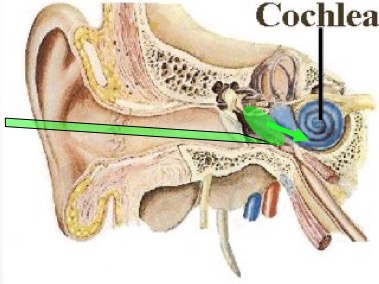In the clinic, there are many conditions affecting the ear that can benefit from treatment with locally-applied drugs. They include:-
1) Meniere's disease - which has symptoms of rotatory vertigo (the sensation of spinning), hearing loss to sounds of low pitch, tinnitus (hearing roaring or whistling sounds when in a quiet room) and a feeling of "fullness" or pressure in the ear.
2) Sudden hearing loss - If you wake up one morning and the sensitivity of hearing in one or both ears has declined. You feel deaf and cannot hear quiet sounds (such as the ticking of a clock). Typically you need to urgently contact your ENT (ear nose & throat) doctor or otologist.
In either of these cases, doctors are now commonly using intratympanic therapy, which is a procedure where drug solution is injected through the eardrum (tympanic membrane) into the middle ear space. From the middle ear the drug (shown green below) can spread into the inner ear. This allows drug to reach the inner ear at much higher concentrations than they would if given systemically (such as by intravenous injection or taken orally).

The drugs commonly used are steroids (dexamethasone-phosphate or methylprednisolone-hemisuccinate) or gentamicin, which is used to suppress dizziness caused by a hyperactive or unstable balance system.
In our research, we are interested in how much of the applied drug gets into the inner ear, where in the ear the drug distributes to, and how long the drug remains in the ear. Other groups are pursuing new therapies "in-the-pipeline" which may treat a wider range of inner ear disorders.
In general, we have found that small-molecule drugs are lost very rapidly from the middle ear so that entry into the inner ear occurs only briefly. Some are lost quickly from perilymph so they do not get chance to distribute to apical regions and only briefly treat basal regions of the ear. However, delivery of larger molecules, including peptides and antibodies is now possible which allows these substances to be distributed throughout the human cochlea. We strive to improve the quantitative reliability of drug applications to the ear in the knowledge that will undoubtedly improve their effectiveness.
